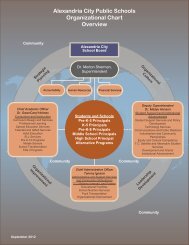Fundamentals of Human Growth and Development - Alexandria City ...
Fundamentals of Human Growth and Development - Alexandria City ...
Fundamentals of Human Growth and Development - Alexandria City ...
You also want an ePaper? Increase the reach of your titles
YUMPU automatically turns print PDFs into web optimized ePapers that Google loves.
Young Children’s Love Objects<br />
By Marilyn Sherman<br />
It’s foolish--<br />
I know it--<br />
I’ll try to<br />
Outgrow it,<br />
But meanwhile...<br />
It’s my blanket <strong>and</strong> me!<br />
–Sung by Linus in You’re a Good Man Charlie Brown<br />
The lovable Peanuts character Linus is probably the most blanket-toter <strong>of</strong> all time. He<br />
speaks for every young child who cherishes a special cuddly object. Whether it’s scuffy stuffed<br />
animal or a rag <strong>of</strong> a blanket, that object probably gets dragged from place to place as the child<br />
plays. And it’s probably stroked <strong>and</strong> snuggled when the child settles down to sleep or feels blue.<br />
Why do many children become attached to certain objects, <strong>and</strong> what function do these<br />
love objects serve? To us, most <strong>of</strong> the objects look worthless enough to belong on the junk heap.<br />
But many psychologists believe that these well-loved objects give valuable insights into the<br />
young child’s feelings <strong>and</strong> stages <strong>of</strong> development.<br />
ON BECOMING A PERSON<br />
It probably takes infants some time after they are born to get the dim sensation <strong>of</strong> being<br />
separate–no longer a part <strong>of</strong> their mothers. Until that time, psychologists believe, attachments<br />
are very slight <strong>and</strong> babies are not likely to have love objects.<br />
THE NEED FOR SNUGGLES<br />
Love objects may satisfy a baby’s seated need for physical closeness <strong>and</strong> contact, some<br />
child experts say. You’ve probably observed that babies prefer s<strong>of</strong>t, smooth, warm objects to<br />
hard, cold, rough ones. British psychologist John Bowlby maintains that babies have a need for<br />
intimate contact, which calls “primary object clinging.”<br />
Classic experiments by University <strong>of</strong> Wisconsin researcher Harry Harlow support this<br />
idea. Harlow studied baby macaque (muh-kak’) monkeys, whose emotional patterns are<br />
strikingly similar to human babies’. He made two mock “mothers” for the monkeys, one <strong>of</strong> s<strong>of</strong>t<br />
terry cloth <strong>and</strong> the other <strong>of</strong> wire mesh. Harlow found that the baby monkeys overwhelmingly<br />
preferred the cloth “mother” to the wire one, even when the wire one dispensed milk <strong>and</strong> the<br />
cloth one did not. Other experiments showed that the monkey’s bond with cloth “mother” not<br />
only was deep <strong>and</strong> long-lasting but also gave them the security to explore in new situations.<br />
Baby monkeys raised on a bare wire cage floor “survived with difficulty--if at all-- their first five<br />
days, “ Harlow reported.<br />
Harlow’s experiments suggest that comfortable physical contact is necessary <strong>and</strong><br />
important in forming love attachments. The research helps to explain the satisfaction young<br />
children get from cuddly dolls, blankets, or animals. These objects recall the cuddly comfort <strong>of</strong> a<br />
mother or mother substitute.<br />
Child <strong>Development</strong> Unit32












